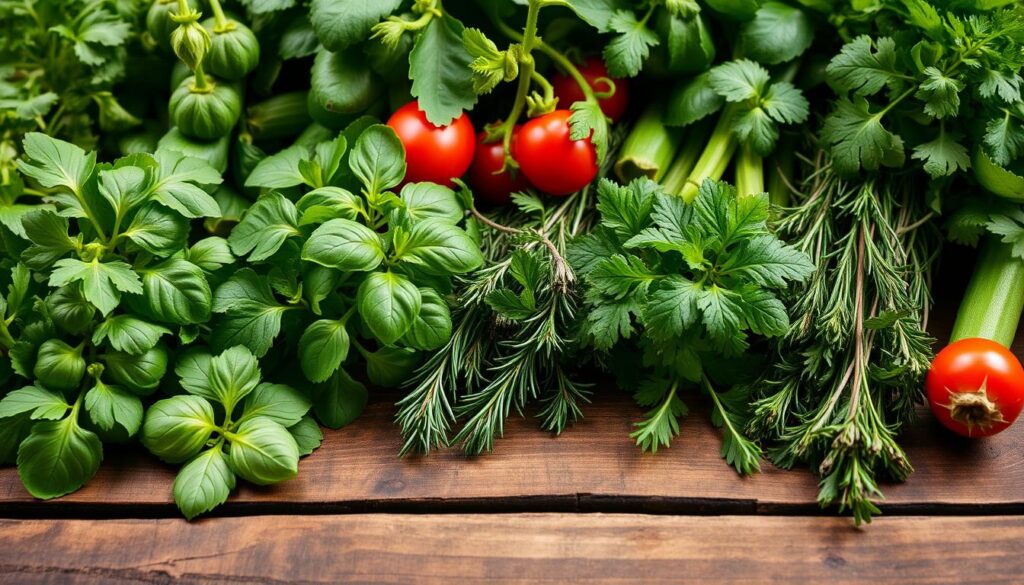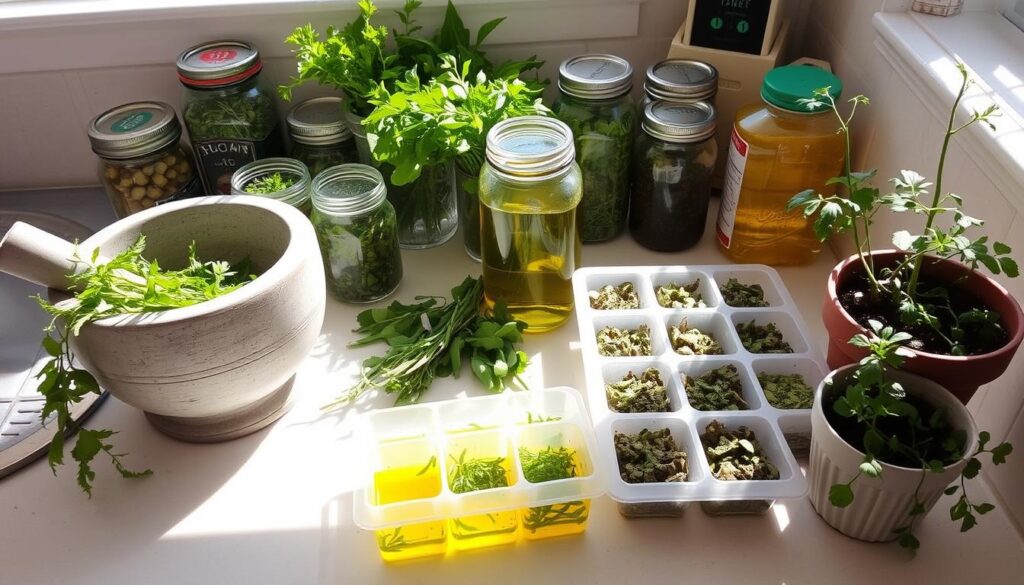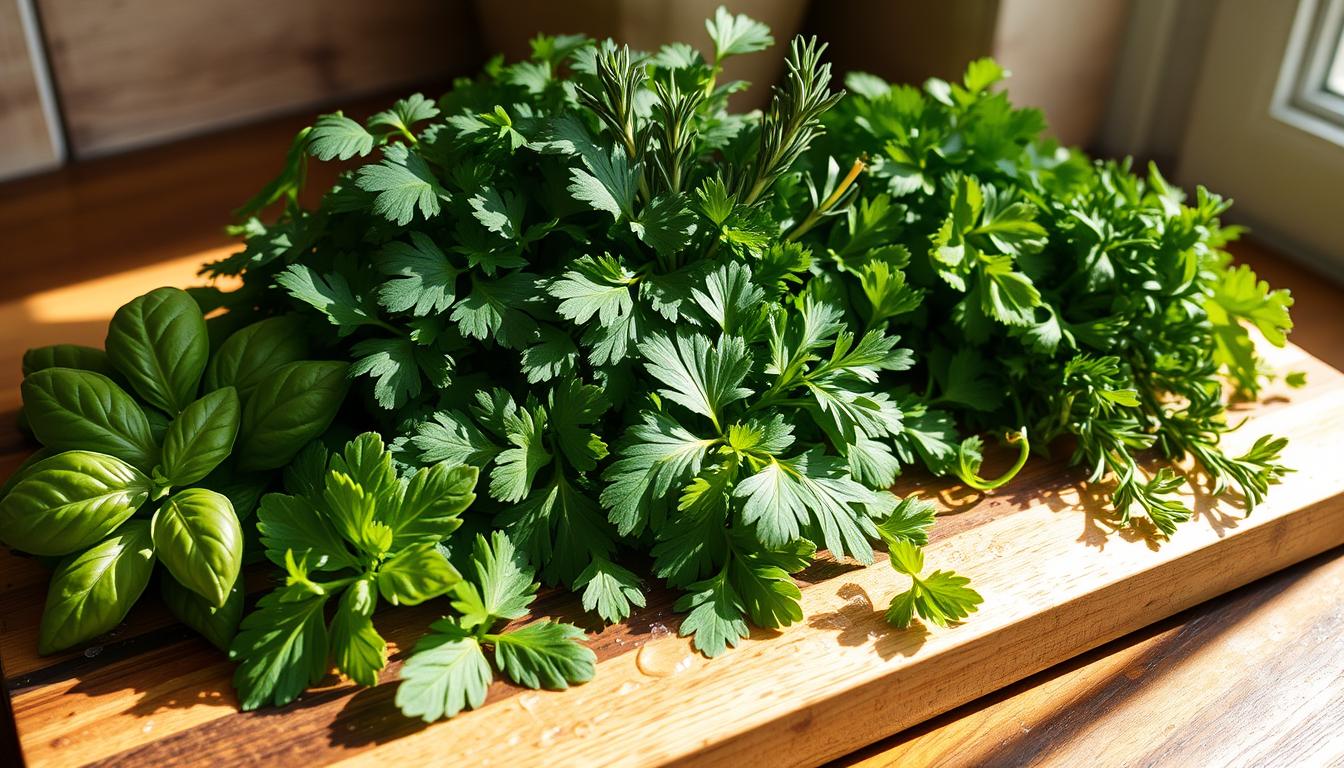This post contains affiliate links.
Ready to add magic to your cooking? Fresh herbs are the answer! These green wonders boost flavors, turning simple dishes into feasts. With over 75 herbs to choose from, your dishes will be a hit!
Imagine picking fresh basil or rosemary from your herb garden. These herbs not only flavor your food but also add vitamins and antioxidants. It’s like having a health boost in your kitchen!
Whether you’re new to cooking or a pro, fresh herbs are your best friend. They’re easy to grow and can make even a frozen pizza taste like a gourmet meal. Are you ready to explore the world of fresh herbs?
Key Takeaways
- Fresh herbs can transform simple dishes into culinary masterpieces
- There are 75-100 different herbs in the world to explore
- Herbs are categorized into soft herbs and woody herbs
- Growing your own herbs is cost-effective and rewarding
- Fresh herbs are packed with vitamins and antioxidants
- Proper storage can extend the life of fresh herbs for weeks
- Herb starter kits are available for $30 or less
The Power of Fresh Herbs in Culinary Creations
Fresh herbs are a secret weapon in your kitchen. They turn simple dishes into amazing meals. With their bright flavors and smells, herbs make your cooking stand out. Let’s see how these green wonders can change your meals.
Enhancing Flavors Naturally
Imagine eating a perfectly roasted squash with rosemary and thyme. The herbs make your taste buds sing. Fresh herbs like basil, cilantro, and parsley add richness to food. They’re nature’s way to enhance flavors, without any fake stuff.
Health Benefits of Incorporating Fresh Herbs
Herbs are not just for taste. They’re also full of antioxidants that boost your immune system. Rosemary can help with digestion, and mint can calm an upset stomach. Using these herbs in your meals is like giving your body a health boost.
From Garden to Plate: The Joy of Using Home-Grown Herbs
There’s nothing like using herbs you’ve grown yourself. With a few tips, you can grow herbs on your windowsill. Imagine using fresh basil in pasta sauce or cilantro in salsa. It’s more than cooking; it’s connecting with your food.
| Herb | Flavor Profile | Best Uses |
|---|---|---|
| Basil | Sweet, peppery | Pasta sauces, salads |
| Rosemary | Woody, piney | Roasted meats, potatoes |
| Cilantro | Citrusy, slightly peppery | Salsas, curries |
| Thyme | Minty, slightly lemony | Soups, stews |
Ready to start your herb-filled cooking journey? Begin small, try new things, and watch your dishes come to life. Your taste buds will love you for it!
Essential Fresh Herbs Every Home Cook Should Know
Ready to spice up your cooking? Let’s explore fresh herbs! These green wonders can make your dishes amazing. Planning your herb garden is key for a year-round supply.

Chefs love flat-leaf Italian parsley, thyme, rosemary, and chives. These herbs are secret weapons in kitchens. But there’s more! With over 100 types, your taste buds will love it!
Here’s a quick guide to some must-have herbs for your kitchen:
- Basil: Sweet and aromatic, perfect for Italian and Asian cuisines
- Cilantro: Zesty and fresh, a staple in Mexican and Indian dishes
- Mint: Cool and refreshing, great for drinks and desserts
- Oregano: Earthy and robust, essential for Mediterranean flavors
- Sage: Savory and slightly peppery, ideal for poultry and stuffings
Want to grow your own organic herbs? Plant them in rich, loamy soil with full sun. Water regularly and give them space. Remember to snip stems often to encourage regrowth.
“Fresh herbs are like nature’s flavor bombs. They can turn an ordinary meal into a gourmet experience!”
In the 1960s, parsley was the only herb on most plates. Now, we have so many choices! From basil to tarragon, each herb adds its own special touch. So, grab those kitchen shears and let’s get snipping!
Soft vs. Woody Herbs: Understanding the Difference
Dive into the world of culinary herbs and discover the magical difference between soft and woody varieties. Your herb recipes will never be the same once you grasp these distinctions!
Soft Herbs: Basil, Parsley, Cilantro, and More
Soft herbs are the delicate darlings of the kitchen. Think basil, parsley, cilantro, mint, and chives. These tender beauties have edible stems and pack a punch in fresh salads and light sauces. They’re perfect for last-minute flavor boosts in your cooking adventures.
Woody Herbs: Rosemary, Thyme, and Sage
Woody herbs are the tough guys of herb seasonings. Rosemary, thyme, sage, and oregano fall into this category. With their sturdy stems, they can withstand the heat of longer cooking times. These herbs shine in roasts, stews, and hearty dishes.
Best Uses for Each Type of Herb
Knowing when to use soft or woody herbs can elevate your cooking game. Soft herbs are your go-to for fresh, vibrant flavors. Sprinkle them on dishes just before serving. Woody herbs, on the other hand, are perfect for infusing flavors during cooking. They release their essential oils slowly, creating depth in your dishes.
| Herb Type | Examples | Best Uses | Storage Tips |
|---|---|---|---|
| Soft Herbs | Basil, Parsley, Cilantro, Mint | Salads, Garnishes, Light Sauces | In water, covered with plastic bag |
| Woody Herbs | Rosemary, Thyme, Sage, Oregano | Roasts, Stews, Braised Dishes | Wrapped in damp paper towel, in plastic bag |
Remember, fresh herbs can replace dried ones at a 3:1 ratio. So, unleash your inner chef and start experimenting with these flavorful greens in your next culinary creation!
Fresh Herbs: Choosing, Storing, and Preserving
Ready to take your cooking to the next level with fresh herbs? Let’s explore how to pick, store, and preserve these flavor-packed gems. Whether you’re a pro in the kitchen or just starting out, these tips will change your cooking game.

When picking herbs, choose vibrant bunches over small packets. Look for leaves that are perky and avoid wilted or brown ones. Fresh herbs are always the best choice!
Keeping your herbs fresh is crucial. Soft herbs like cilantro, parsley, and basil can last up to 3 weeks. Simply put them in a glass of water, cover with a plastic bag, and refrigerate. Don’t forget to change the water every few days to keep them fresh.
For woody herbs like rosemary and thyme, use a different method. Wrap them in a damp paper towel, put them in a bag with holes, and store in the fridge. They’ll stay fresh for about a week.
Preservation Techniques for Organic Herbs
Want to enjoy your organic herbs for longer? Try these preservation methods:
- Freeze soft herbs in ice cube trays with olive oil
- Dry hardy herbs by hanging them in bunches
- Create herb-infused oils or vinegars
Mastering these techniques means you’ll always have flavorful herbs ready to enhance any dish!
| Herb Type | Storage Method | Lifespan |
|---|---|---|
| Soft Herbs (Basil, Cilantro, Parsley) | In water, covered, refrigerated | Up to 3 weeks |
| Woody Herbs (Rosemary, Thyme) | Wrapped in damp paper towel, refrigerated | About 1 week |
| Dried Herbs | Airtight container, cool dark place | 6-12 months |
Cooking Techniques to Maximize Fresh Herb Flavors
Ready to make your dishes pop? Let’s explore the world of herb seasonings. We’ll learn how to bring out the fresh flavors of herbs in your cooking.
When to Add Fresh Herbs During Cooking
Timing is key when using herbs. Delicate herbs like basil and cilantro are best added at the end. This way, their flavors stay bright and fresh.
Hardy herbs, like rosemary and thyme, can cook for longer. They add strong flavors to your dishes.
Herb Infusions and Oils
Want to boost your dish’s flavor? Make herb-infused oils or waters. Steep herbs in hot oil or water to create tasty bases for dressings and more. These infusions keep the herb’s essence and add depth to your recipes.
Creating Herb Bouquets and Sachets
Herb bouquets and sachets are great for soups and stews. They add flavor during cooking and are easy to remove. Try a mix of thyme, parsley, and bay leaves for a French touch.
| Herb Type | Best Addition Time | Cooking Method |
|---|---|---|
| Delicate (Basil, Cilantro) | End of cooking | Garnish, quick stir |
| Hardy (Rosemary, Thyme) | Beginning or middle | Slow cook, infuse |
| Mixed (Bouquet Garni) | Throughout cooking | Simmer, remove before serving |
Fresh herbs have 3-4 times more flavor than dried ones. So, use less dried herb when substituting. Happy cooking, herb lovers!
Fresh vs. Dried Herbs: When to Use Each
Ever wondered how to make your food taste amazing? The secret is knowing when to use fresh versus dried herbs. Let’s explore the world of herb seasonings and see how they can transform your dishes.
Fresh herbs have a strong flavor, but they can be expensive. Dried herbs are cheaper and last longer. But, not all herbs dry well.
The Fresh vs. Dried Dilemma
Herbs like parsley, tarragon, and chives are best when fresh. They lose their flavor when dried. But, don’t dismiss dried herbs yet! Oregano, marjoram, and thyme get better with drying.
When using dried herbs instead of fresh, use one-third of the amount. So, if a recipe calls for 3 teaspoons of fresh rosemary, use 1 teaspoon of dried.
Timing is Everything
Fresh herbs are best added at the end of cooking to keep their flavor. Dried herbs, with their strong taste, should be added early to bring out their flavor.
| Herb Type | Best Used | Flavor Profile |
|---|---|---|
| Fresh Herbs | End of cooking | Light, delicate |
| Dried Herbs | During cooking | Deep, spicy |
Herb drying is more than just a convenience. It’s an art that can make your herbs even better. So, next time you cook, choose the right herbs to make your dishes unforgettable!
Starting Your Own Herb Garden: Tips for Success
Ready to start your herb garden? It’s a fun and rewarding journey. You can grow organic herbs with little effort. Whether you have a big backyard or a small windowsill, you can create your own herb paradise.
Selecting the Right Herbs for Your Climate
Pick herbs that do well in your area. Most herbs need 4-5 hours of sun a day. Ideal is 7-8 hours. Good choices include oregano, thyme, sage, rosemary, garlic, and basil. They taste great and are good for you too!
Container Gardening for Small Spaces
Don’t let small space stop you! Herbs grow well in pots. Use soil like Miracle-Gro® Moisture Control® Potting Mix. Container plants need water every couple of days.
Maintenance and Harvesting Techniques
Water your herbs every day, especially in pots. Feed them with liquid plant food every 1-2 weeks. Harvest often to keep plants bushy. But, harvest before they flower for the best taste. Here’s how to preserve your harvest:
| Herb Type | Preservation Method |
|---|---|
| Thick-leaved (rosemary, sage) | Air-dry indoors |
| Thin-leaved (basil) | Freeze in ice cube trays |
Follow these tips, and you’ll have a thriving herb garden. Happy planting!
Creative Ways to Use Fresh Herbs Beyond Cooking
Fresh herbs aren’t just for cooking! You can use them in many other ways. Let’s look at some fun and new uses for these fragrant sprigs.
Want to turn your home into a spa? Add some lavender or mint to your bathwater. It’s like making your own spa treatments right in your tub!
Love gardening? Use your organic herbs for crafts. Press rosemary or thyme between book pages for beautiful art. Or make aromatic candles with infused oils.
Beauty and Wellness
Use fresh herbs for DIY beauty treatments:
- Mix crushed basil leaves with honey for a refreshing face mask
- Create a rosemary hair rinse to boost shine and growth
- Blend chamomile with yogurt for a soothing eye treatment
Herbs have been used for centuries in medicine. Peppermint tea can ease digestion, and sage gargle might soothe a sore throat. Always check with a healthcare professional before trying new herbal remedies.
| Herb | Non-Culinary Use | Benefit |
|---|---|---|
| Lavender | Pillow sachet | Promotes relaxation |
| Rosemary | Hair rinse | Stimulates hair growth |
| Mint | Room freshener | Natural deodorizer |
So, next time you have extra herbs, don’t waste them. Get creative and find new ways to use your fresh, organic herbs beyond cooking!
Conclusion
Fresh herbs are the unsung heroes of your kitchen. They turn ordinary meals into culinary masterpieces. From basil’s 100 species to dill’s blood pressure-lowering prowess, these green wonders pack a flavorful punch and a health boost. You’re not just adding taste; you’re sprinkling wellness onto your plate!
Herb gardening isn’t just a hobby; it’s a ticket to a stress-free zone. Imagine plucking fresh rosemary or mint from your windowsill garden – it’s like having a mini spa moment right in your kitchen. Plus, your wallet will thank you for skipping those pricey store-bought herbs.
Whether you’re a seasoned chef or a kitchen newbie, fresh herbs are your secret weapon. They’re versatile, nutritious, and let’s face it, they make your dishes Instagram-worthy. So go ahead, embrace the herbal revolution. Your taste buds, your health, and your social media followers will all be impressed!
FAQ
What are some of the most widely used fresh herbs in cooking?
What’s the difference between soft and woody herbs?
How do you store fresh herbs to keep them fresh longer?
When should you add fresh herbs during cooking?
How do you substitute dried herbs for fresh herbs?
What are some tips for starting an herb garden?
What are some creative ways to use fresh herbs beyond cooking?
This post contains affiliate links.

